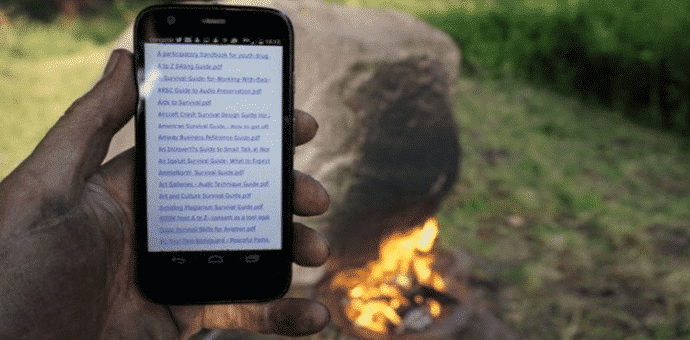This Boulder is a Fire-Powered Wi-Fi Router
This rock placed strategically in the middle of a park of an outdoor Springhorn Hof museum in Germany, appears like an ordinary boulder at the first glance. A closer look at it, however, shows that this inconspicuous 1.5-ton boulder is actually an art installation with a fire-powered Wi-Fi router and has a hidden USB drive inside.
Created by Berlin artist Aram Bartholl, the sculpture named ‘Keepalive’, tries to highlight the contrast between ancient and modern survival techniques. Keepalive is a thermoelectric Wi-Fi router powered up by lighting a campfire underneath the boulder. Once it’s activated, which is done by starting a fire at the base of the rock, the router connects to any nearby phones, piping in a list of downloadable survival guides. The network runs on Piratebox, a DIY-software that creates offline wireless networks.
From Bartholl’s website:
Visitors are invited to make a fire next to the boulder to power up the Wi-Fi router in the stone which then reveals a large collection of PDF survival guides. Thepiratebox.cc-inspired router which is NOT connected to the Internet offers the users to download the guides and upload any content they like to the stone database. As long as the fire produces enough heat the router will stay switched on.
The survival PDFs are loaded onto a USB drive located inside the cavity of the rock. The drive contains a range of interesting, bizarre PDF survival guides for the modern world, including a Do it yourself Divorce Guide’, a ‘Drone Survival Guide’, a ‘Single Woman’s Sassy Survival Guide’, and ‘A Steampunk Guide to Sex’. Some of these strange uploads might have been the work of naughty visitors, but Bartholl doesn’t mind.
In fact, having created Dead Drops, the world’s most epic file sharing network consisting of USB flash drives embedded into walls all over the world, he’s all about public data-sharing. But Keepalive, named after the technical term for a message sent between devices to check connectivity, is meant to be more obscure.
It’s designed to be helpful as much in the wilds of the online world as much as a future apocalyptic dystopia: “Following the advice in the survival guides prepares you…for solo survival in the chaotic world of computer programming as much as for solo survival in the wilderness,” Bartholl writes. The combination of both primitive and high-tech means of survival is fitting, given that access to the digital data in the first place requires one of the oldest forms of technology: fire.
“It’s not about easy access,” Bartholl said, speaking to Hyperallergic. “It has a whole dystopian idea to it, like, will we need something like this in the future? Or somebody finding this in a hundred years – is it still working and they figure something out and they make a fire, or is there going to be a moment where we’re going to need to make fire again to get access to the data?”

